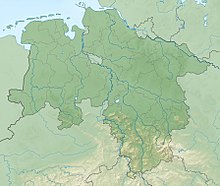Stoteler Moor
Coordinates: 53 ° 25 ′ 37 " N , 8 ° 35 ′ 23" E
The Stoteler Moor , which is located south of the village of Stotel in the Lower Saxony district of Cuxhaven , consists of raised bog grassland and a birch break landscape. Together with the directly adjacent nature reserve Königsmoor and Plackenmoor near Schwegen, the moor complex is managed under the collective name of the Hahnenknooper Moore nature reserve .
General
The nature reserve Stoteler Moor with a size of 192 ha was designated as a nature reserve in 1984 . Part of this area is owned by the district of Cuxhaven , part is owned by the state of Lower Saxony . The enclosed grassland areas are still partly farmed extensively , provided they are still passable. Like the neighboring areas, it is designated as an FFH area .
In the course of the waterlogging, the existing system of paths in the Stoteler Moor nature reserve was rededicated by land consolidation , assigned to the nature reserve and thus canceled as a path. As a replacement, a cinder path was built in 2001, which separates the nature reserve from the district's own grassland. In 2004, the nature reserves were freed from the old barbed wire fences and other contaminated sites by a work force from the Cuxhaven district. The late blooming bird cherry and the Hercules shrub, also known as giant hogweed , are undesirable in the NSG .
The nature reserve borders the federal motorway 27 to the west .
Waterlogging
From winter 2004 to 2008, parts of the area were watered by the state of Lower Saxony under the direction of the nature conservation office of the district of Cuxhaven and NLWKN (Lower Saxony State Agency for Water Management, Coastal and Nature Protection) by damming the surface water by means of ditch damming and dams. Due to a land consolidation in 2001, areas could be exchanged and a drainage ditch that ran through could be repealed and dammed. The replacement drainage system for the Stotel-Sandberg district was completed in 2005 by the Office for Agricultural Structure (AfA).
Management
The peripheral areas of the nature reserves are owned by the district of Cuxhaven and are used extensively by agriculture as a buffer zone . Until December 31, 2004, the patronage of all nature reserves was the Lüneburg district government as a subsidiary of the Lower Saxony state government and the superior authority of the Cuxhaven district. After the administrative reform in 2004, all rights and obligations were transferred to the district of Cuxhaven from January 1, 2005. The state-owned areas developed z. T. the NLWKN . The nature conservation authorities on site are supported by a supervisor from the Lower Saxony State Hunters' Association.
nature
An area of approx. 65 ha is a rinsing area overgrown with reed bed , which was created in the 1980s when the A27 was built. This is a wetland with old reed stock, which is worth protecting as a habitat for the birds . The round-leaved sundew (Drosera rotundifolia) and the middle sundew (Drosera intermedia) can be found in this area.
Due to the given inner dams, this area forms an inaccessible refuge for the local fauna, which has also been granted special protection by those authorized to hunt in the form of voluntary time restrictions. The wild boar has made its permanent debut here.
There are also bodies of water, swampy zones, dry dams and moorland .
Wildlife
The nature reserve has been a habitat for the crane since 2001 . This is demonstrably a breeding area. The crane needs wet bog areas to protect against predatory game, as it sleeps standing in inaccessible water areas and breeds.
In 1996 the avi fauna was recorded by a biologist in an expert opinion, whereby the following breeding birds were detected:
Birds of prey: goshawk , buzzard , Eurasian Hobby , Kestrel , Marsh Harrier , Sparrowhawk , short-eared owl
Water game, including the Stoteler See: mallard , teal , gray goose , water rail , coot .
Other: snipe , curlew , nightjar , lapwings , wood lark , skylark , yellow wagtail , Bluethroat , Whinchat , Stonechat , robins , sedge warbler , reed warbler , warbler , Rotrückenwürger = Red-backed Shrike , Great Gray Shrike , Zilpzalp , Whitethroat , blackbird , wren , Goldammer , great tit , blue tit , Tasmanian tit , garden warbler, corncrake
Resting birds: great crested grebe , great cormorant , gray heron , bean goose , tufted duck , goosander , buzzard , red kite , hen harrier , woodcock .
Due to the waterlogging, some plover species were added ( redshank , dunlin and others). The waterlogging is of course not extensive in the aforementioned areas.
Reptiles
There is a healthy population of reptiles, with the adder dominating. The shy grass snake can also be found near the water. Slow worm and forest lizard are abundant.
The habitat is only slightly disturbed and is very attractive to dragonflies .
Precautions
It is forbidden to enter the nature reserves outside of the paths. In the swampy wetlands there is a high risk of death. If you slide into the mud, you hardly have the opportunity to free yourself again.

